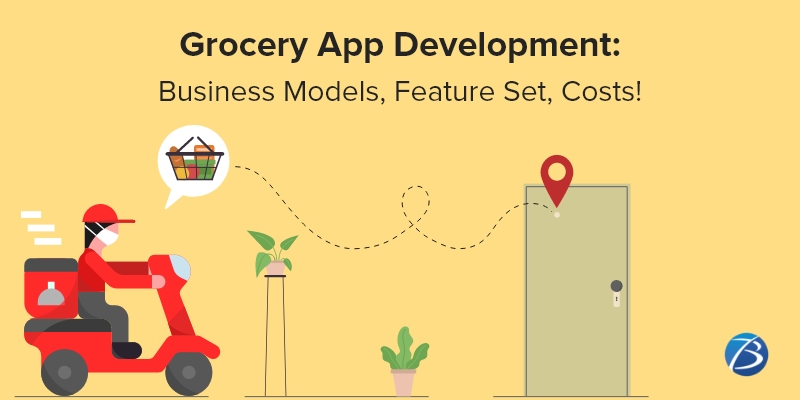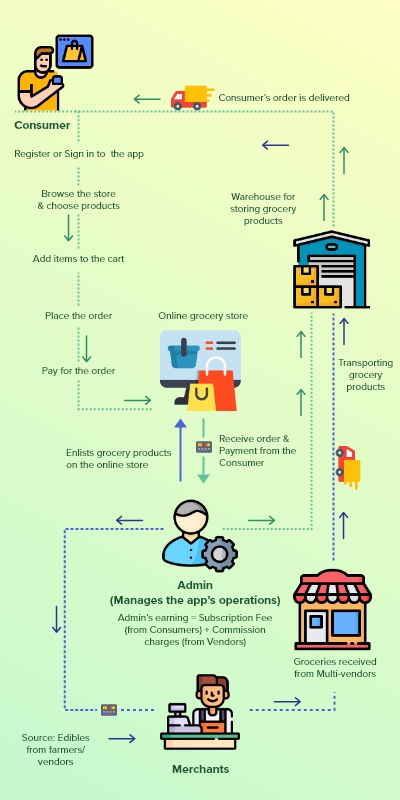Comprehensive Insights on Grocery App Development: Business Models, Feature Set, Costs

Grocery delivery apps have been one of the most popular on-demand app categories amongst customers ever since mobile apps started influencing our daily activities. The convenience of online ordering, avoiding long queues at physical stores, receiving home delivery of essentials, and that too with a few taps on the smartphones have made grocery apps a lucrative option amongst global consumers. And, the social distancing trend during the pandemic has fuelled grocery app adoption like never before.
Here are some interesting market stats regarding grocery app adoption. As per a study conducted by the online portal insiderintelligence.com,
- “The market value of online grocery sales in the US is expected to hit 243 Billion USD by the year 2025!”
- “Walmart Inc. has emerged as the most successful retailer in the US, in the online grocery sales category, followed by Amazon and Kroger!”
The demand for grocery apps is sky-high amongst consumers. No wonder, several entrepreneurs are investing in grocery app development to make the most of the customer demand. This post throws light on multiple aspects of grocery app development – Business Models, functioning, essential Features, and Cost! A quick read will help you gather handy information for your upcoming grocery app development project.
How does an On-demand Grocery Mobile App Function?
An on-demand grocery application offers a virtual grocery store from where the customers can purchase products online and get them delivered to their doorstep. Online grocery stores tie up with local retailers and delivery partners. This is how a grocery app functions:
Step # 1
A user registers with the app by entering the required details like name, delivery address, contact number, and so on; and sets a password. The user then logs into the app using a mobile number/email ID and password.
Step # 2
The user browses the offerings by the online store to search for the desired items. The user can apply certain filters to simplify the search process and readily find specific brands or products.
Step # 3
The consumer chooses the items, defines the number of items needed, and adds them to the virtual cart offered by the app.
Step # 4
The user confirms the order & delivery address of the consumer, and then makes the payment using any one of the online payment gateways offered by the app. Here, consumers get to choose whether they would like to pick up their order from the store or opt for home delivery. Some grocery apps even allow the customers to choose the date and time slots for order delivery.
Step # 5
The admin receives the request. The request is then forwarded to the manager of the grocery store.
Step # 6
The store manager responds to the request by either accepting or declining it. And, the admin reverts back to the customer by sending a notification that the order has been placed and is being processed.
Step # 7
The store manager then generates the order and notifies the admin that the delivery process had begun. The order tracking link is generated and updated in the customer’s profile. Consumers can now track their order in real-time and learn about the date and approximate time when their order is arriving.
Step # 8
The order gets delivered to the customer and the delivery service notifies the consumer as well as the admin that the products have been delivered to the end customer.
How online grocery business works?

On-demand Grocery App Development: Business Models Types

Inventory Model
Entrepreneurs following this model purchase grocery supplies or products from different sources and third-party providers. These products are then stored in their warehouses. The platform takes orders directly from online buyers and delivers their orders using either an internal or an external delivery network. The orders shipped to the consumers bear the logo of the online platform’s brand, irrespective of the vendor from whom the item was purchased.
Business brands like Big Basket follow this model; they obtain grocery item directly from farmers, retailers, or other providers; stores the products in their warehouses; and then sells those products under their own brand name.
The businesses that have adopted the inventory model take care of all aspects themselves; right from monitoring the products’ consistency, to managing product distribution, to handling customer services. Since they manage the supply chain directly without an intermediary involved, the profit margins are much higher as compared to other models.
However, this model involves greater amounts of infrastructural investments and operational expenses. This is because, the business needs to set up as well as administer warehouses, conduct quality control activities, and take care of consumer order transportation. Also, perishable products need to be washed off if they are not used within a certain time period.
Online Marketplace involving Multiple Vendors
As per this model, the online platform does not handle the stock directly; instead, it connects customers with nearby grocery stores. When the consumer searches for a specific item, multiple options from different stores are displayed. Once the order is placed, the business brand collects the products from that particular store and ships those items to the customer using their own fleet of the transportation network and delivery personnel. Consumers are delivered orders bearing the logo of the respective brands from where the products were purchased. The multi-vendor model has proved to be one of the most profitable grocery app models so far. The popular brand Amazon follows this business model in all the regions where it operates.
Aggregator Model
The business platforms following this model, simply link app users to grocery stores in their area. The delivery operations are managed by the respective store owners who receive consumer orders. Such aggregators collaborate with local store owners and enlist names of those grocery stores along with their offerings. Consumers are offered a host of grocery store options to choose from. Once the consumers select the products from the listed stores and make the purchase using the app, the order is processed and directed to the respective store owners. Now, it’s the store’s responsibility to ship the order to buyers. Here, the online platform is just the facilitator that acts as a mediator between the buyer and the store owner.
Grocery Store Self Model
This model involves the business brand hiring a grocery app development service for tailoring a customized app that will showcase the offerings of that particular store or brand. Here, the brand maintains an IT team who manages the entire set of activities starting from app maintenance, updating menu lists, collecting payments, and delivering customer orders.
This model has been adopted by several single stores or grocery store chains like Walmart.
On-demand Grocery App Development: Must-have Features
Take a look at the must-have features to include in your on-demand grocery app!
Consumer Panel Features
Registration: Consumers register themselves with the app using their contact number and e-mail ID. After successful registration, users create their profiles with a user name and password.
Social Media Login: The user should have the option of logging in using their social media credentials for a quick login process.
Advanced Search: Advanced search options enabled with filters allow users to effortlessly single out particular brands, product categories, etc., and also set a price range for their search. This way, navigation becomes smooth, easy, and speedy leading to a hassle-free shopping experience.
Add to cart and Checkout: These features allow adding items to a virtual shopping cart and confirming the order once consumers are done. Thereafter, buyers are directed to make the payment.
Secure Payment Gateways: The availability of multiple payment options like debit/credit cards, UPI, net banking, meal vouchers, etc. will streamline the payment process.
Selection of Delivery Date & Timing: Customers can decide the delivery time and date as per their convenience and availability to receive the order.
Real-time Order Tracking:
In-app Chatting or Calling: Buyers can contact and interact with delivery personnel in real-time.
Real-Time Tracking: Users can track the delivery on the map in real-time.
Referrals: Users can recommend the app to their friends and acquaintances and the users receive special discounts for successful referrals.
Return/Replacement/Refunds: Customers are provided the option to replace items purchased and also return damaged items and get a refund for them. Usually, a customer has to initiate the return process through the app within a certain time from the date of purchase.
Wish List: If a user wishes to save an item to be purchased at a later date, it can be added to the wish list. Also, when certain products desired by the customer are not available in the inventory at that moment, they can be added to the wish list. The consumers are notified whenever the item/s is back in stock.
Favorites: This section is used for storing the list of frequently bought products for the consumers’ future reference.
Order History: It records order summaries and proves handy when consumers wish to repeat their orders.
Push Notifications: Users can be notified about new arrivals, promotional offers, discounted prices, stock clearance discounts, etc.
Customer Reviews and Ratings: Consumers share their feedback and reviews/ratings about a particular product. This helps in attracting more buyers and broadening the customer base.
Customer Support: This feature allows consumers to put forth their queries or concerns regarding products purchased, refunds, or payment transactions. Customer concerns/queries are addressed by the customer support staff or the admins.
Admin Panel Features
Interactive Dashboard: It displays crucial informative data pertaining to business insights, sales, order tracking, real-time delivery status, etc.; only the admin can see such information. This feature allows admins to monitor as well as manage the entire ordering and delivery system taking place through the grocery app.
Admin Login: Admin login to enable access to the back-end of the app. Admins can carry out tasks like resetting password resets and managing campaigns, notifications, etc.
User Management: Admin can check on all the users registered with the app and manage them.
Return/Replacement/Refund Management: Once the consumer places a return/replacement request, the admin analyzes it and can approve or dismiss the request. If the request is approved, the admin processes the return or refund.
Product Management/Content Management: All content and product lists displayed on the app are managed by the admin. The admins are empowered to make any modifications, add/remove products to the app’s list, or enable/disable products that are already displayed on the app.
Order Management: Using this feature an admin can assign orders to delivery persons or grocery store partners; then monitor the order delivery in real-time and learn about the amount earned for each order.
Payment Management: Admin controls and manages all payment transactions, refunds, and matters concerning taxes and commissions, and also settles payment-related disputes.
Inventory Management: The admin checks the real-time availability of grocery products to avoid instances of product shortages. Based on this information, admins can make correct and informed decisions.
Business Reports: It provides insightful real-time business reports; the admin can apply filters and attributes for viewing some specific data. Using this data admins can keep a watch on the efficiency and performance of the delivery network.
Delivery Panel Features
Delivery Request Notification: When a consumer order is confirmed this notification is received by the delivery vendor along with the necessary details like delivery location, address, consumer’s name, contact number, etc.
Accepting/Rejecting Delivery Request: The delivery vendor can accept or reject the delivery request. Usually, a delivery request is declined if the customer’s location is too far or doesn’t fall under the specified distance applicable for getting free delivery. Admins are notified immediately in such cases.
In-app communication: The delivery persons and the customers can get in touch and interact with one another using in-app chatting or voice calling options.
Route Optimization: This feature leverages Google maps to display the shortest route to reach consumers.
Live Location Tracking via GPS: Well, this feature is very useful for the delivery person as well as the consumer. GPS integration helps the delivery person easily find out the delivery location and the buyer comes to know the exact time the order is being delivered.
Consumers’ Digital Signature: Certain grocery delivery apps have this feature. Here, consumers need to digitally sign on the app once they receive the order. This way, the receipt of products is confirmed by the buyer and there’s no room for any confusion later on.
Delivery Completion Notification: Once, the products are delivered to the buyer, the delivery person marks the task as completed. The app sends a notification to the admin stating the delivery status along with the order number.
Store Owner Panel Features
Store locator: Store owners are able to relocate their stores on the map. Users can also locate the store on the map.
Store pick-up: This option is provided to consumers who would like to waive off the delivery charges and yet enjoy a hassle-free shopping experience.
Store Profiles Management: The store owner can modify the store’s profile and update any changes remotely from any location.
Real-time tracking via GPS: This feature allows the store owner to track the shipment and verify the real-time status of the delivery.
On-demand Grocery App Development: Cost Considerations
Now comes the most vital, yet tricky part of grocery app development – the estimated project cost. Well, estimating the cost is not as easy as it sounds. The cost of development solely depends on factors like the level of complexity of the app’s features, the number of features, the platforms selected, the country where the grocery app is operating, the pricing model opted for, the app development resources hired, and many more.
The average cost of developing a grocery app ranges from $10,000 to $30,000 if the app caters to a single platform Android or iOS. For cross-platform app development, the expenses may rise up to $50,000.
It has been observed that outsourcing grocery app development services from experienced offshore teams has been the most profitable strategy for entrepreneurs.
Summing Up:
I hope this blog has provided all the necessary information you were looking for regarding grocery app creation! To sum up, grocery app development is quite complex and may be challenging for start-ups and novice entrepreneurs. In such cases, it is advisable to partner with a competent Grocery app development company that will assist you all throughout the product development lifecycle starting from app ideation to deployment and support post-deployment.
Other articles and publications:
- +1 (469) 277-0804
- 8305 Tripoli Trl, Frisco, TX 75034, United States
- www.biz4solutions.com/





